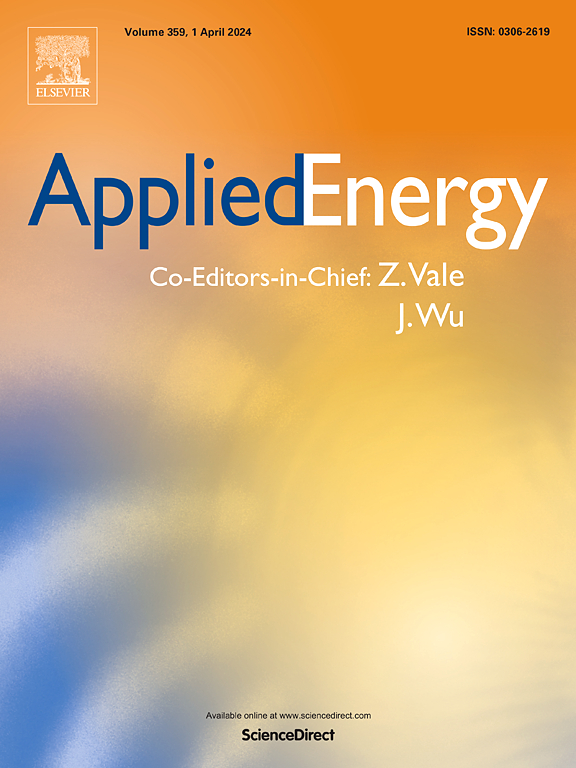开发基于实时链路的预测能量管理策略,利用实验驱动的退化模型延长燃料电池汽车的使用寿命
IF 11
1区 工程技术
Q1 ENERGY & FUELS
引用次数: 0
摘要
燃料电池电动汽车(fcev)面临的耐久性挑战主要是由于功率变化和运行范围影响电池退化。这个问题可以通过能源管理策略(EMS)来缓解,许多以耐久性为重点的研究都采用了预测性EMS (P-EMS)来提高性能。然而,现有的策略往往依赖于高度不确定的未来车辆轨迹,如速度或电力需求,导致视野长度缩短和最优性的重大损失。本研究提出了一种新颖的基于链路的、以持久性为重点的P-EMS,在每个链路的基础上进行优化,实现了近乎最佳的性能。关键创新在于将问题从轨迹优化重新表述为参数优化,表示为二次规划(QP)问题,从而实现实时执行。退化模型分为动态和准静态两部分,其中准静态模型是根据实验数据建立的。在此基础上,提出了一个多目标最优控制问题,通过动态规划(DP)算法揭示了退化与系统效率之间的Pareto最优关系,并保证了全局最优性。基于DP结果的见解,本文提出的方法对问题进行了解析性的重新表述,需要容易预测的驾驶参数,如代表连接条件的行驶时间和能源需求。仿真结果表明,当优先考虑电池退化保护时,所提出的方法实现了与DP相当的高性能,具有最小的最优性损失(燃料经济性损失为1.5 %,燃料电池退化损失为6.7 %),同时显示出令人印象深刻的平均计算时间仅为2.5 ms。本文章由计算机程序翻译,如有差异,请以英文原文为准。
Development of a real-time link-based predictive energy management strategy for extending FCEV lifespan using an experiment-driven degradation model
Fuel cell electric vehicles (FCEVs) face durability challenges primarily due to cell degradation influenced by power variations and operational ranges. This issue can be mitigated through an energy management strategy (EMS), with many durability-focused studies employing predictive EMS (P-EMS) for high performance. However, existing strategies often rely on highly uncertain future vehicle trajectories, such as velocity or power demand, leading to a shortened horizon length and significant loss of optimality. This study proposes a novel link-based, durability-focused P-EMS optimized on a per-link basis, achieving near-optimal performance. The key innovation lies in reformulating the problem from trajectory optimization to parameter optimization, expressed as a quadratic programming (QP) problem, which enables real-time implementation. The degradation model consists of dynamic and quasi-static operations, where the quasi-static model is developed based on experimental data. A multi-objective optimal control problem is then formulated, revealing a Pareto optimal relationship between degradation and system efficiency through a dynamic programming (DP) algorithm that ensures global optimality. Building on insights from DP results, the proposed approach analytically reformulates the problem, requiring easily predictable driving parameters such as travel time and energy demand that represent link conditions. The simulation results reveal that, when prioritizing cell degradation protection, the proposed method achieves high performance comparable to DP, with a minimal loss of optimality (1.5 % in fuel economy and 6.7 % in fuel cell degradation) while showing an impressive average computational time of merely 2.5 ms.
求助全文
通过发布文献求助,成功后即可免费获取论文全文。
去求助
来源期刊

Applied Energy
工程技术-工程:化工
CiteScore
21.20
自引率
10.70%
发文量
1830
审稿时长
41 days
期刊介绍:
Applied Energy serves as a platform for sharing innovations, research, development, and demonstrations in energy conversion, conservation, and sustainable energy systems. The journal covers topics such as optimal energy resource use, environmental pollutant mitigation, and energy process analysis. It welcomes original papers, review articles, technical notes, and letters to the editor. Authors are encouraged to submit manuscripts that bridge the gap between research, development, and implementation. The journal addresses a wide spectrum of topics, including fossil and renewable energy technologies, energy economics, and environmental impacts. Applied Energy also explores modeling and forecasting, conservation strategies, and the social and economic implications of energy policies, including climate change mitigation. It is complemented by the open-access journal Advances in Applied Energy.
 求助内容:
求助内容: 应助结果提醒方式:
应助结果提醒方式:


